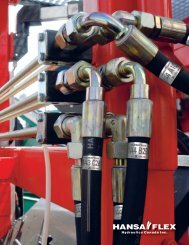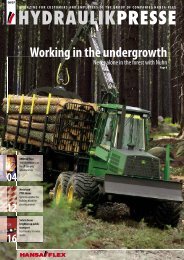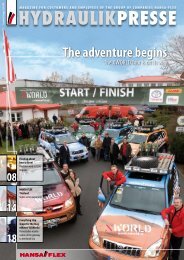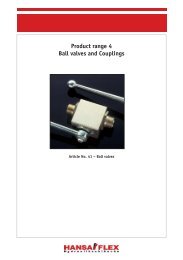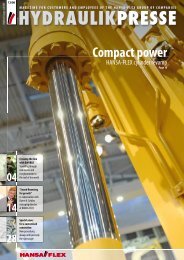hydraulik - HANSA-FLEX Hydraulics Canada Inc.
hydraulik - HANSA-FLEX Hydraulics Canada Inc.
hydraulik - HANSA-FLEX Hydraulics Canada Inc.
You also want an ePaper? Increase the reach of your titles
YUMPU automatically turns print PDFs into web optimized ePapers that Google loves.
in an open process, by a vacuum infusion method<br />
which resulted in a much more even covering and<br />
also, incidentally, greatly improved working conditions<br />
on the factory fl oor. When manufacturing the<br />
upper and lower shells of a rotor blade, specially<br />
designed moulds are employed to enhance the<br />
surface properties and dimensional stability of the<br />
blades based on optimised geometries. The upper<br />
and lower shells each have their own mould, into<br />
which glass fi bre and reinforcing material is infused<br />
according to a special plan. The moulds are<br />
hermetically sealed and high-performance pumps<br />
then generate a vacuum. Epoxy resin is then added<br />
to enhance durability in continuous operation. The<br />
fi bre-glass mats are saturated evenly with epoxy<br />
resin, providing them with a uniform quality fi nish.<br />
The prepared rotor shells are fi nally tempered at<br />
around 85 degrees Celsius.<br />
PTFE corrugated hoses guarantee<br />
trouble-free work-fl ow<br />
The liquid epoxy resin is fed to the blade moulds<br />
through a pipework system. Immediately before<br />
the resin enters the mould, the hardener is added<br />
to it in a mixer. The mixer and the moulds are connected<br />
by PTFE corrugated hoses from <strong>HANSA</strong>-<strong>FLEX</strong>,<br />
and the choice has proved to be ideal. The hoses are<br />
resistant to the solvents, and prevent epoxy resin<br />
from being deposited on the walls and clogging<br />
the lines.<br />
ISSUE AUGUST 2008<br />
<strong>Hydraulics</strong> – the linchpin to<br />
achieve faster production<br />
processes<br />
Enercon recently optimised its rotor blade production<br />
processes by installing a so-called power-hinge<br />
supplied by a Canadian manufacturer. Whereas the<br />
upper and lower shells previously had to be brought<br />
together by cranes prior to bonding, the new machine<br />
enables the process to be speeded up. Supported<br />
on powerful hydraulics, the power-hinge<br />
quickly brings the components together in one<br />
simple operation. For this to happen, however, the<br />
work platforms around the upper shell mould have<br />
to be removed. The <strong>HANSA</strong>-<strong>FLEX</strong> branch in Barleben,<br />
which serves Enercon in Magdeburg, devised<br />
and installed a hydraulic solution featuring three<br />
power packs, hydraulic cylinders and the complete<br />
control and pipework systems. At the press of a button,<br />
the work platforms are hydraulically retracted,<br />
enabling the upper shell to be swung down onto<br />
the lower shell. With this system, branch manager<br />
Peter Mandel and his team succeeded in providing<br />
Enercon with a highly eff ective solution.<br />
WIND ENERGY<br />
A fl at bed trailer leaving Enercon premises in Magdeburg with two rotor blades – the optimised blade<br />
geometry enhances the effi ciency of wind energy plants signifi cantly<br />
A pioneering<br />
wind power plant<br />
(GroWiAn)<br />
The idea of using the wind as a source<br />
of energy really began to � y in Germany<br />
during the 1980s with the development<br />
of the so-called “GroWiAn” (Grosse<br />
Windkraftanlage) generation of largescale<br />
wind power plants. The publicly<br />
funded large-scale wind power plant in<br />
the Kaiser-Wilhelm-Koog municipality<br />
near Marne in the German state of Schleswig-Holstein<br />
served as a test bed for<br />
the technology. With a hub height of 100<br />
metres, it was long classed as the tallest<br />
wind turbine in the world.<br />
The � rst trial was conducted on July 6,<br />
1983. The plant, featuring many new<br />
technologies previously untested on<br />
such a scale, was never able to operate at<br />
full capacity because of shortcomings in<br />
its design and construction materials. In<br />
August 1987 it was dismantled. Still today,<br />
developers and designers of stateof-the-art<br />
wind power plants continue<br />
to bene� t from the know-how gleaned<br />
from this early pioneer.<br />
23<br />
H������



